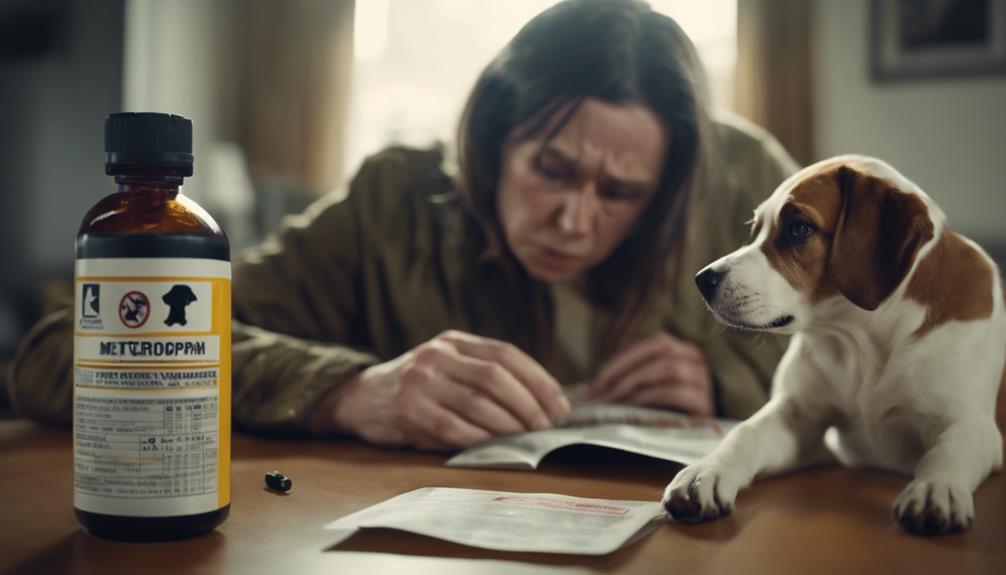Metoclopramide, a medication often employed in veterinary practices to alleviate nausea in dogs, presents a multifaceted approach in addressing gastrointestinal distress. However, beyond its utility in managing queasiness, an intricate landscape of potential side effects and nuanced dosage considerations emerges.
As pet owners navigate the realm of canine health management, understanding the intricacies of Metoclopramide use becomes imperative for fostering optimal well-being in furry companions. The delicate balance between its benefits and risks beckons for a closer examination into the nuanced application of this medication for your queasy pup.
Key Takeaways
- Metoclopramide helps with nausea and vomiting in dogs.
- Dosage varies by weight and condition, best given before meals.
- Watch for side effects with accidental overdoses; contact vet if needed.
- Use cautiously in certain conditions like GI issues, seizures, or pregnancy.
Overview of Metoclopramide in Dogs
Metoclopramide, commonly prescribed for dogs experiencing nausea and vomiting, functions by stimulating motility in the upper gastrointestinal tract and is known by the brand name Reglan. This medication crosses the blood-brain barrier, blocking dopamine uptake, which aids in its antiemetic effects.
Administered orally as a pill or syrup, with an injectable form also available, it can be given with or without food, preferably 20 minutes before a meal. Dosage varies based on the dog's weight and condition, and it is crucial to follow the veterinarian's instructions meticulously.
Metoclopramide is generally used for short-term relief, and any concerns or adverse reactions should be promptly reported to the vet for further guidance.
Uses of Metoclopramide for Nausea
For managing nausea in dogs, metoclopramide serves as a valuable prescription medication with its efficacy in stimulating upper gastrointestinal tract motility. This medication is particularly useful in cases where dogs experience nausea due to various causes such as gastrointestinal disorders, chemotherapy, or postoperative recovery.
By enhancing the movement of food through the digestive system, metoclopramide helps alleviate symptoms like vomiting and discomfort, promoting overall gastrointestinal function. Its ability to cross the blood-brain barrier and block dopamine uptake further contributes to its anti-nausea effects.
Veterinarians may prescribe metoclopramide to improve gastric emptying and reduce the urge to vomit, making it a beneficial option for dogs struggling with queasiness and associated issues.
Dosage Guidelines for Dogs

When determining the appropriate dosage of metoclopramide for dogs, veterinarians consider the individual dog's weight and specific medical condition.
Guidelines for metoclopramide dosage:
- The typical dose for dogs is 0.1 to 0.2 mg per pound of body weight every 6 to 8 hours.
- The duration of treatment can vary but is often short-term, ranging from a few days to a few weeks.
- Always follow the veterinarian's prescribed dosage and administration schedule to ensure the medication's effectiveness and minimize the risk of side effects.
Side Effects to Watch For
Monitor your dog closely for potential adverse reactions while using metoclopramide. Timely recognition of side effects is crucial for ensuring your pet's well-being during treatment.
Common side effects may include restlessness, drowsiness, diarrhea, or changes in appetite. Some dogs may experience more severe reactions such as tremors, muscle spasms, or jaundice.
Watch for signs of allergic reactions like swelling, itching, or difficulty breathing. If your dog exhibits any concerning symptoms, contact your veterinarian promptly.
Additionally, be mindful of any behavioral changes, unusual movements, or lack of improvement in your dog's condition. Regularly assessing your pet for side effects can help in managing their health effectively while using metoclopramide.
Precautions and Warnings

Upon initiating treatment with metoclopramide for your dog, it is imperative to adhere to the prescribed precautions and warnings to ensure the safe and effective use of this medication.
- Avoid in Certain Conditions:
- Metoclopramide should be avoided in dogs with gastrointestinal obstructions, injuries, or bleeding.
- Use Caution in Specific Situations:
- Exercise caution when using metoclopramide in dogs with a history of seizures or head trauma.
- Special Considerations:
- Use metoclopramide with care in pregnant or nursing dogs, as well as in dogs with kidney issues.
- Typically intended for short-term use; prolonged use may necessitate closer monitoring.
Administering Metoclopramide Safely
To ensure the safe administration of metoclopramide to dogs, it is crucial to carefully follow the prescribed dosage and guidelines provided by a veterinarian. The dosage of metoclopramide varies based on the dog's weight and condition, so it is essential to accurately measure and administer the medication.
Metoclopramide can be given orally as a pill or syrup, with or without food, although it is generally recommended to administer it 20 minutes before a meal for optimal effectiveness. It is important to adhere strictly to the dosing schedule and not exceed the recommended amount without veterinary approval.
Regular monitoring of the dog's response to the medication is advised, and any concerns or observed side effects should be promptly discussed with the veterinarian.
Handling Metoclopramide Overdose

In the event of an accidental overdose of metoclopramide in dogs, prompt veterinary intervention is imperative to assess and address any potential adverse effects.
Handling Metoclopramide Overdose:
- Contact the Veterinarian Immediately:
- Inform the vet about the situation and the amount of medication ingested.
- Consider Inducing Vomiting:
- If advised by the vet, safely induce vomiting to help remove the excess metoclopramide from the dog's system.
- Seek Emergency Veterinary Care:
- If the overdose is significant or if severe symptoms develop, seek immediate veterinary assistance for proper evaluation and treatment.
Monitoring Your Dog's Response
Monitoring your dog's response to metoclopramide involves observing for any changes in behavior or symptoms that may indicate the medication's effectiveness or potential side effects.
Look for improvements in your dog's nausea, vomiting, or other gastrointestinal issues, as these are the intended outcomes of metoclopramide. Additionally, watch out for any signs of side effects such as restlessness, drowsiness, diarrhea, or muscle spasms.
Keep track of how frequently your dog vomits or experiences nausea after starting the medication. If you notice persistent or worsening symptoms, contact your veterinarian for further guidance.
Regular monitoring is crucial to ensure that metoclopramide is benefiting your dog without causing any significant adverse effects.
Additional Tips for Metoclopramide Use

When administering metoclopramide to dogs, it is essential to maintain a consistent dosing schedule to optimize the medication's effectiveness and minimize the risk of adverse reactions.
Here are three additional tips for the use of metoclopramide in dogs:
- Monitor for Side Effects: Keep an eye out for any signs of adverse reactions such as restlessness, tremors, or unusual behavior. Contact your veterinarian if you notice any concerning symptoms.
- Administer with Care: Ensure the medication is given as prescribed by your vet, following the correct dosage and administration instructions to achieve the best results for your furry companion.
- Regular Veterinary Consultations: Schedule regular check-ups with your vet to discuss your dog's response to metoclopramide, any concerns you may have, and to adjust treatment as needed.
Conclusion
In conclusion, Metoclopramide serves as a valuable tool for managing nausea and vomiting in dogs. Understanding the proper usage, dosage guidelines, potential side effects, and precautions is crucial for ensuring the safe and effective administration of this medication.
By closely monitoring your dog's response and seeking veterinary guidance when needed, you can help alleviate your pet's queasiness and improve their overall well-being.




